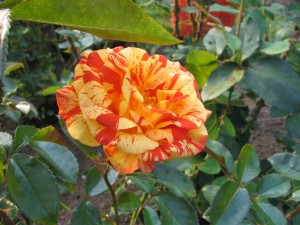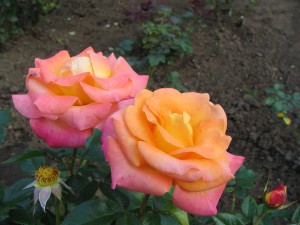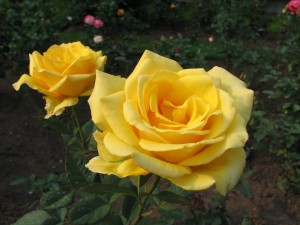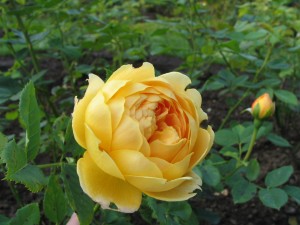Garden Director Jamie Colen on growing roses:
Zoning in
The roses here at the Fuller Gardens begin their season-long bloom in mid- June and continue blooming through the first frost. We have hundreds of varieties so the bloom time is staggered making for a colorful display from June until October. The secret to achieving success with roses first depends on the survivability of the plant, otherwise known as hardiness. Hardiness is defined as the very lowest temperature the plant can endure before the cells freeze and burst. Plants are rated by hardiness zones across the world and designated by the lowest average temperature that is reached. These zones are rated from 1-11 with 1 being the coldest, near the Arctic and 11 the warmest, down near the Florida Keys. You can tell how hardy a plant is by its rating. The seacoast of NH is in Zone 5a, so when we choose roses to plant we must be certain they are suited for our climate zone. If you choose a rose that is rated for zone 4 you can be sure it is very tough. Even roses rated for our area (5a) can be damaged by constant freezing and thawing. By taking measures to ensure that the bush stays at constant 32 degrees and protecting against desiccation and sun scalding, we can help plants survive the eventual thaws and deep freezes throughout the winter. Helping the plant maintain a constant cold temperature is what winter protection is all about. Another very important aspect of a plant’s ability to survive winter is the proper de-acclimation from cold to warm temperatures.
If a rose is to reach perfection it needs protection
A crucial step to successful winter survival is to halt deadheading the roses in the first week of September. This allows the hips containing the seeds to develop which naturally slows the bush from producing further growth. (Only the mature canes will harden off to survive the winter) Second step during the cool months of October is to not prune the canes, but leave them intact as these will supply the plant with a source of water and nutrients as the temps drop. Simply tie the canes together so the winter winds do not damage them. A deep snow cover that lasts all winter is ideal protection for roses. However, it’s impossible to predict how snowy New England winters will be so we mimic snow cover by bringing in composted soil (not taken from the beds). Form a cone of soil up to 2 feet or so (larger amount for bigger roses) around the base of each individual bush when the ground has just begun to freeze, usually early December. This timing is crucial because if the insulating soil is applied too early, it can invite mice, voles and other small mammals to tunnel and feed on the rose canes during the winter. After the soil pile has frozen, you may apply salt marsh hay or another type of insulating layer to help it stay frozen and to deflect winter sun from warming the soil pile. The key here is to keep the rose bush frozen through winter and keep it from breaking dormancy. In early Spring, allow the bush to re-acclimate to warmer weather as the soil thaws in the spring by slowing removing the hay and soil. A good signal that the soil is beginning to warm is when the crocus begin to bloom.
Be kind to your soil
 Soil is a living ecosystem and needs to be cared for as much as the plants that grow in it. Perform a pH check of your soil every year to make sure your it is between 6.4-6.8. If necessary, apply dolomitic limestone to correct a low Ph situation. Avoid using bark mulch on rose, flower and vegetable beds. These high energy plants prefer more neutral ph soil levels and the use of bark mulch will actually lower pH due to the fact that it is made up of acidic lumber waste. Rather, use neutral pH compost or dehydrated cow manure and work a few inches of that into the soil every spring. This will increase soil life, aid in water absorption and also the best way to help soil hold nutrients longer. The idea is to feed the soil, so the soil may feed the plants. The more organic ingredients you add into the soil, the less you will need to fertilize and the more neutral the pH your soil will become. For weed control, cultivate the soil weekly with a long handled four-prong cultivator. This promotes aeration and allows the soil to warm up more efficiently. Use an organic fertilizer once or twice a year if you notice yellowing or otherwise slow growth. Do not use foliar fertilizers: although they act fast to green up leaves, they do nothing to enrich the soil and do not last long. Many of these and other chemical fertilizers are not absorbed by the plants efficiently, and much of the remaining chemicals run-off into the water table, creating nutrient loading and algae blooms in rivers, lakes and eventually, the ocean.
Soil is a living ecosystem and needs to be cared for as much as the plants that grow in it. Perform a pH check of your soil every year to make sure your it is between 6.4-6.8. If necessary, apply dolomitic limestone to correct a low Ph situation. Avoid using bark mulch on rose, flower and vegetable beds. These high energy plants prefer more neutral ph soil levels and the use of bark mulch will actually lower pH due to the fact that it is made up of acidic lumber waste. Rather, use neutral pH compost or dehydrated cow manure and work a few inches of that into the soil every spring. This will increase soil life, aid in water absorption and also the best way to help soil hold nutrients longer. The idea is to feed the soil, so the soil may feed the plants. The more organic ingredients you add into the soil, the less you will need to fertilize and the more neutral the pH your soil will become. For weed control, cultivate the soil weekly with a long handled four-prong cultivator. This promotes aeration and allows the soil to warm up more efficiently. Use an organic fertilizer once or twice a year if you notice yellowing or otherwise slow growth. Do not use foliar fertilizers: although they act fast to green up leaves, they do nothing to enrich the soil and do not last long. Many of these and other chemical fertilizers are not absorbed by the plants efficiently, and much of the remaining chemicals run-off into the water table, creating nutrient loading and algae blooms in rivers, lakes and eventually, the ocean.
Water: the lifeblood
 Natural rainfall is best, as rain water contains many nutrients that are picked up as the rain falls through the air. Irrigation, whether a soaker hose or standard sprinklers, must be done correctly for it to be effective. Irrigation on grass, flower or vegetable gardens must be regular (weekly, NOT daily) and deep in times of low natural rainfall. We suggest at least once a week for one hour per move or per station. Deep watering encourages root growth to go further down into the soil, protecting the plants against drought. Incorrect and/or frequent watering is the number one killer of plants!!
Natural rainfall is best, as rain water contains many nutrients that are picked up as the rain falls through the air. Irrigation, whether a soaker hose or standard sprinklers, must be done correctly for it to be effective. Irrigation on grass, flower or vegetable gardens must be regular (weekly, NOT daily) and deep in times of low natural rainfall. We suggest at least once a week for one hour per move or per station. Deep watering encourages root growth to go further down into the soil, protecting the plants against drought. Incorrect and/or frequent watering is the number one killer of plants!!
Choose well
The proper selection of the varieties you grow will dictate how much time you will need to spend caring for your roses. Daily care is usually not necessary but it depends on the variety and the number or bushes you choose to grow. There are many shrub-type roses that are disease resistant and have numerous blooms per bush with very little care. However, the flowers tend to be small. Hybrid Tea roses have some of the biggest and most fragrant roses known, with a much longer and larger bloom cycle . They do, however, require more care but are well worth the effort!
 A rose is a rose…
A rose is a rose…
Not exactly! There are hundreds of classifications and many thousands of varieties are available. Roses are typically classed depending on their parentage or history. We tend to see many different classifications of roses incorrectly lumped into the ‘Old Garden Rose’ category, which really consists of many sub-classes, but essentially describes roses that were hybridized before 1897. There are many wonderful roses in this area that are disease resistant, hardy, and are still being cultivated and available. Some are recurrent (repeat blooming during the season) and some are non-recurrent (only bloom once in early summer). Many ‘David Austin’ roses have been cultivated from recurrent blooming old garden roses and will reward even the beginning rose grower the very first year with many blooms. It must be noted that many tend to have a smaller repeat bloom cycle. Hybrid tea roses (Grandiflora, Floribunda and Climbers included) are surely the biggest classification these days with good reason — they tend to have big, colorful blooms, are highly fragrant and bloom constantly throughout the season.
 Pruning is key and here’s the key to pruning
Pruning is key and here’s the key to pruning
Pruning is performed in early spring, just as the buds begin to swell and through the growing season, (this is known as deadheading or removing spent blooms) This first pruning in the Spring can be one of the most daunting tasks to the beginning grower. The entire crop of the seasons flowers depend on a correct spring pruning job. With practice pruning becomes very easy once you know what to look for. Bush roses that have numerous, thinner canes supporting smaller flowers and generally need less and lighter pruning. Hybrid Teas with fewer, thicker canes that produce bigger, heavier flowers will need more intense pruning. This is all relative to the growth habit and size and shape of the plant. Regardless, they all require a similar technique. Start by pruning back one cane at time to where the cane is green, or right above a swelling bud. You will notice that not all canes are green on the outside, some are dark red or brown, but you can identify a living cane by looking closely for a green cambium layer surrounding the pith after a cut. Continue until all the canes are cut back to something green, or living. Now go back and prune out the canes that are thinner than a pencil, saving only the strongest, best shaped ones in order to create and maintain a good shape. Remember, these canes need to be stout enough to provide a strong foundation to support the weight of many roses. Sometimes, you will only find thin canes depending on the age and variety of the rose. This is why we begin pruning by saving everything first, then go back to thin out. Deadheading the spent flowers after every subsequent bloom will encourage new growth. The technique of deadheading is similar to the first pruning, but you may not need to go so far down, just to the second or third leaflet or bud scar,
Insects and Fungus
Insect damage and disease can be avoided by following some basic guidelines. Simply choose plants that are resistant to certain diseases such as ‘blackspot’, ‘powdery mildew’ and ‘rust’. If you have established plants that are susceptible to certain diseases, good sanitation can help prevent future problems. Clean all fallen leaves up from around the plant each fall and spring and keep dead leaves from accumulating. This will keep fungus spores from infecting the rest of the bush. Protecting the new leaves with a natural fungicide such as ‘Greencure’ or ‘Milstop’ (potassium bicarbonate) is very helpful in stopping fungus before it begins. Apply one every two weeks, especially in cool, moist conditions. Insect damage can explode given certain favorable conditions. Aphids feed on the tops of roses near the buds and can simply be sprayed off leaves with a stream of water. Lady beetles if present, will devour and control aphid populations with no problems, so be careful about spraying anything on roses until you observe what beneficial insect is present! Spider mites may be the most damaging single pest to roses. They are found on the bottom of leaf surfaces on lower canes and typically begin severe damage as their population increases when temperatures climb into the 90’s. When infestations are severe, yellow pin hole spots appear and webbing can be found near the base of leaves. Defoliation is rapid. Spider mites do not like moisture or cool weather, so occasionally spraying the lower leaves during hot periods is a very effective control method. An application of an ovicide (egg killer) can be performed once in the spring on the soil – this is also very effective and safe. Japanese beetles and European chafers continue to be a major problem in the northeast, but they can be controlled by targeting them when they are grubs. Their damage may first be noticed in late summer where dead and brown patches of grass are apparent, this is because the white beetle grubs feed on turf grass roots just below the soil. Grass damage will occur in the spring when the adults emerge and again after the adults mate, lay eggs and those eggs hatch at the end of the summer. In addition to dead areas of grass, you may notice large swaths of the lawn dug up by skunks, opossums and raccoons that are in search of these high protein grubs. Under severe infestations, entire lawns may be killed in a very short time. There are several control measures and products that can be bought at your local garden center if damage is bad, however, this is a last resort! (you also may not need to apply these products every year, once the major population is controlled) Thorough watering is always recommended after application, so be sure to follow all instructions with these products to the letter! Remember, pests are pests to us because they are feeding on something we are caring for – but in the natural world they all are a part of the ecosystem and will find a balance, so do not over-react when you see damage! We need to observe and think about what action, if any, is necessary before we choose to apply a control measure.





